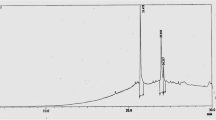Abstract
The methanol extract of Careya arborea bark (MECA) was tested for antioxidant and hepatoprotective activity in Ehrlich ascites carcinoma (EAC) tumor-bearing mice. Tumor control animals inoculated with EAC showed a significant alteration in the levels of antioxidant and hepatoprotective parameters. The extract treatment at 50, 100 and 200 mg/kg body weight doses given orally caused a significant reversal of these biochemical changes towards the normal in serum, liver and kidney when compared to tumor control animals indicating the potent antioxidant and hepatoprotective nature of the standardized extract.
Similar content being viewed by others
References
Gupta M, Mazumder UK, Sambath Kumar R, Sivakumar T, Vamsi MLM (2004) Antitumour activity and antioxidant status of Caesalpinia bonducella against Ehrlich ascites carcinoma in Swiss albino mice. J Pharmacol Sci 94:177–184
De Wys WD (1982) Pathophysiology of cancer cachexia: current understanding and areas for future research. Cancer Res 42:721s–726s
Dreher D, Junod AF (1996) Role of oxygen free radicals in cancer development. Eur J Cancer 32:30–38
Natesan S, Badami S, Dongre SH, Godavarthi A (2007) Antitumor activity and antioxidant status of the methanol extract of Careya arborea bark against Dalton’s lymphoma ascites induced ascitic and solid tumor in mice. J Pharmacol Sci 103:12–23
Kirtikar KR, Basu BD (1987) Indian medicinal plants. 2nd edn, vol 2. Bishen Sing Mahendra Pal Sing, Dehradun, pp 1061–1063
Sambath Kumar R, Sivakumar T, Sivakumar P, Nethaji R, Vijayabaskar M, Perumal P, Gupta M, Upal KM (2005) Hepatoprotective and in vivo antioxidant effects of Careya arborea against carbon tetrachloride induced liver damage in rats. Int J Mol Med Adv Sci 1:418–424
Rahman MT, Khan OF, Saha S, Alimuzzaman M (2003) Antidiarrhoeal activity of the bark extract of Careya arborea Roxb. Fitoterapia 74:116–118
Row LR, Sastry CSP (1964) Chemical examination of Careya arborea Roxb. Indian J Chem 2:510–514
Natesan S, Badami S, Cherian MM, Hariharapura R (2007) Potent in vitro cytotoxic and antioxidant activity of Careya arborea bark extracts. Phytother Res 21:492–495
Misra HP, Fridovich I (1972) The role of superoxide dismutase anion in the autoxidation of epinephrine and simple assay for superoxide dismutase. J Biol Chem 247:3170–3175
Beers RF Jr, Sizer IW (1952) A spectrophotometric method for measuring breakdown of hydrogen peroxide by catalase. J Biol Chem 195:133–140
Ohkawa H, Ohishi N, Yagi K (1979) Assay for lipid peroxides in animal tissue by thiobarbituric acid reaction. Anal Biochem 95:351–358
Szatrowski TP, Nathan CF (1991) Production of large amounts of hydrogen peroxide by human tumour cells. Cancer Res 51:794–798
Ravikumar V, Shivashangari KS, Devaki T (2005) Hepatoprotective activity of Tridax procumbens against d-galactosamine/lipopolysaccharide-induced hepatitis in rats. J Ethnopharmacol 101:55–60
Levine RL (2002) Carbonyl modified proteins in cellular regulation, aging and disease. Free Radic Biol Med 32:797–803
Kintzios SE (2006) Terrestrial plant derived anticancer agents and plants used in anticancer research. Crit Rev Plant Sci 25:79–113
Scartezzini P, Speroni E (2000) Review on some plants of Indian traditional medicine with antioxidant activity. J Ethnopharmacol 71:23–43
Acknowledgments
One of the authors (N.S.) thanks the All India Council of Technical Education, New Delhi for awarding a fellowship under QIP and S.H.D. thanks Department of Biotechnology, Government of India, New Delhi for awarding a junior research fellowship and a senior research fellowship.
Author information
Authors and Affiliations
Corresponding author
Rights and permissions
About this article
Cite this article
Senthilkumar, N., Badami, S., Dongre, S.H. et al. Antioxidant and hepatoprotective activity of the methanol extract of Careya arborea bark in Ehrlich ascites carcinoma-bearing mice. J Nat Med 62, 336–339 (2008). https://doi.org/10.1007/s11418-008-0237-0
Received:
Accepted:
Published:
Issue Date:
DOI: https://doi.org/10.1007/s11418-008-0237-0




